
Week 43 of our 52 Meals Challenge and we are delighted to return to Central Asia to check out Afghanistan. Having cooked meals from Uzbekistan, Pakistan, China, and Iran, all of which border this landlocked country (along with Tajikistan and Turkmenistan), it is about time we hit the kitchen to cook up an authentic Afghan Family Feast!
Afghanistan “the land of Afghans”, is the most famous country on the planet if you are judging by the news. No country in the world has dominated the news more than Afghanistan in the last decade and sadly this has been due to all the wrong reasons. Conflict, political instability and economic chaos have been a stark reality of life and have contributed to Afghanistan being the 2nd biggest source of refugees after Syria. For much of the population it is all they have known, however, it has contributed to the population being immensely tough and resilient. It has been invaded by Greek, Arab, Mongol, Mughal, Persian, British, Sikh and USSR empires all of whom have failed to fully capture Afghanistan. The Afghans have a country that despite all the hardships and suffering, they are still proud to call home.
The hardships of Afghanistan have been well publicised, so much so that many people know little else about what goes on in the country. The closest most people may have got is likely to be one of the exports that Afghanistan is famous for including fruits, nuts, handmade rugs/carpets and gems…. definitely NOT cannabis for which Afghanistan was the world’s largest producer as of 2010. Many of the pursuits and activities we hold dear were banned under Taliban rule, and social restrictions prevented pretty much anything that we in ‘the West’ associate with being fun. Life for females was particularly restrictive with education and work being forbidden.
In recent years many of the activities banned under Taliban rule have been coming back including the national sport, buzkashi. This physical and often violent game involves teams of horseman fighting for the carcass of a goat or a calf to circle a post in the ground and place it in a circular goal. In Kabul where the rules tend to be stricter, the game (like football) has 2 halves of 45 minutes, with a 15-minute break in the middle for the players to get the hairdryer treatment from the Afghan Sir Alex. It is often played on Fridays and can attract crowds of thousands of people. Outside of buzkashi more mainstream sports are also flourishing with Afghanistan winning the Asian Football Federation Championship and the national cricket team qualifying for the 2015 World Cup. The number of women participating in sport has also increased significantly!
Another perhaps unexpected past time of many Afghans is bodybuilding, with Arnold Schwarzenegger being a particularly revered character in the nation. Post-Taliban rule, gyms popped up all over the country and it is thought that in Kabul alone there are over 200, all packed to the rafters with Afghan’s pumping iron, watched over by the many posters and pictures of a muscle-bound Arnie that are plastered over the walls. As of 2007 the countries first bodybuilding club for women was formed and women only gyms have popped up around the country, although this remains a contentious topic with many.
Afghanistan is home to approximately 30 million Sunni Muslims, 7 million Shia Muslims and possibly 1 Jew, Zablon Siminitov, an Afghan trader and restauranteur thought to be the last Jew living in Afghanistan. However, prior to the Islamic era, Buddhism was one of the major religious forces in the region and remnants of this time could be found in the Bamiyan Valley of Central Afghanistan (also the location of the world’s first oil paintings) where 2 giant 6th-century monumental statues of Gautama Buddha measuring 55m (125ft) and 38m (180ft) were carved into the side of a cliff. The statues survived a terrible disaster during the advent of Genghis Khan, artillery attacks by the Mughal emperor Aurangzeb, canon fire from the 18th Century Persian King Nader Afshar and the destruction of its face by the 19th century Afghan king, Abdur Rahman Khan. Sadly, they finally succumbed to the Taliban in 2001, when over several weeks they were destroyed using dynamite.
Pashtuns make up the biggest ethnic group in Afghanistan and Pashtunwali is the traditional lifestyle of its people, interpreted by some scholars as “the way of the Afghans” or “the code of life”. There are 3 primary principles to Pashtunwali – Hospitality, Asylum and Justice & Revenge. A notable example of how seriously Pashtuns take these principles and on this occasion the principle of ‘asylum’, involved Petty Officer First Class Marcus Luttrell, the sole survivor of a US Navy Seal team which had been ambushed by Taliban. He was assisted by members of the Sabray tribe who took him into their village repelling attacks from other tribes until word was sent to nearby US forces to secure his rescue. Given the risk this brought to the tribe one can imagine how seriously they take the principle of ‘hospitality’ and regardless of race, religion, nationality or wealth, Pashtun’s will go to great lengths to show their profound respect to all visitors.
We hope our Afghan Feast today would hit the high standards of Afghan hospitality!
Tooting Family Kitchen cooks Aushak, Borani Banjan and Bolani
Working the dough
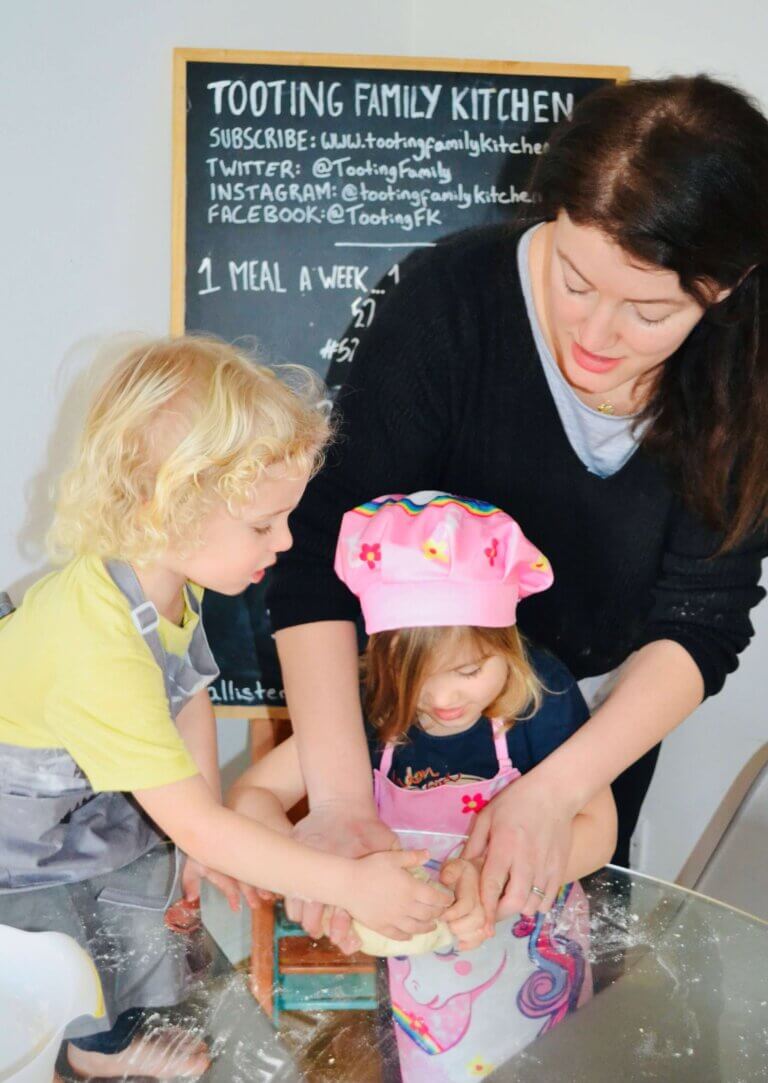
Knife skills
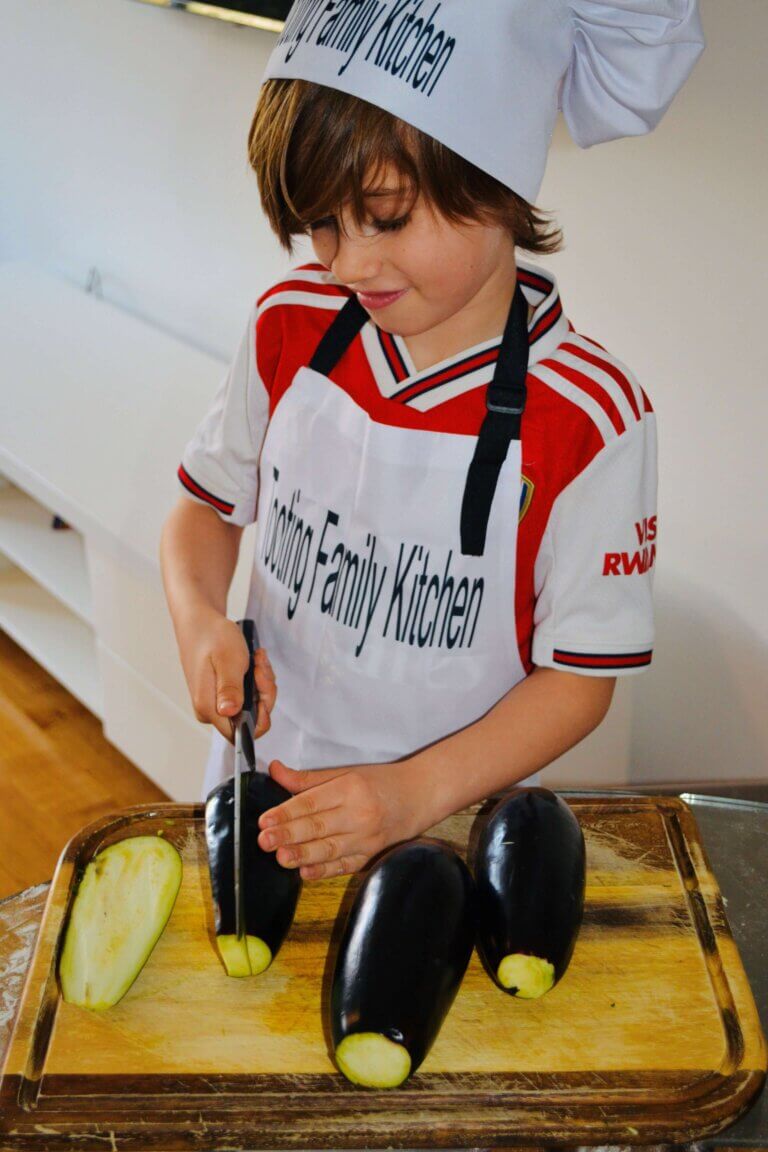
Filling the dumplings
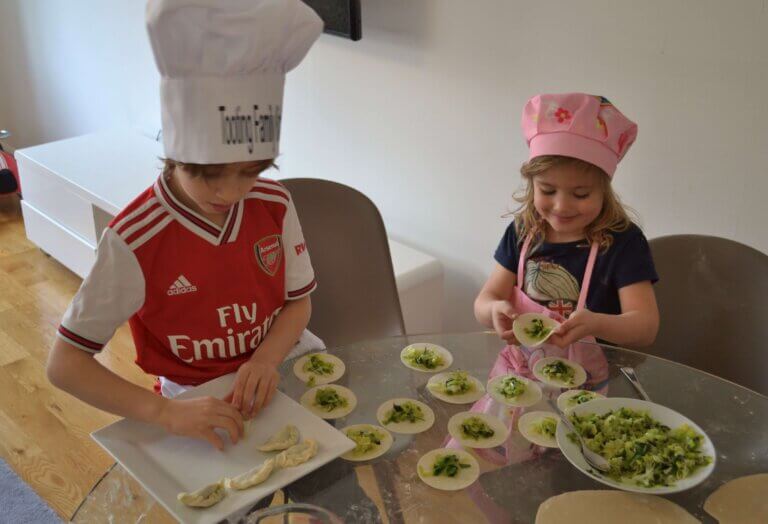
Prepping the bolani
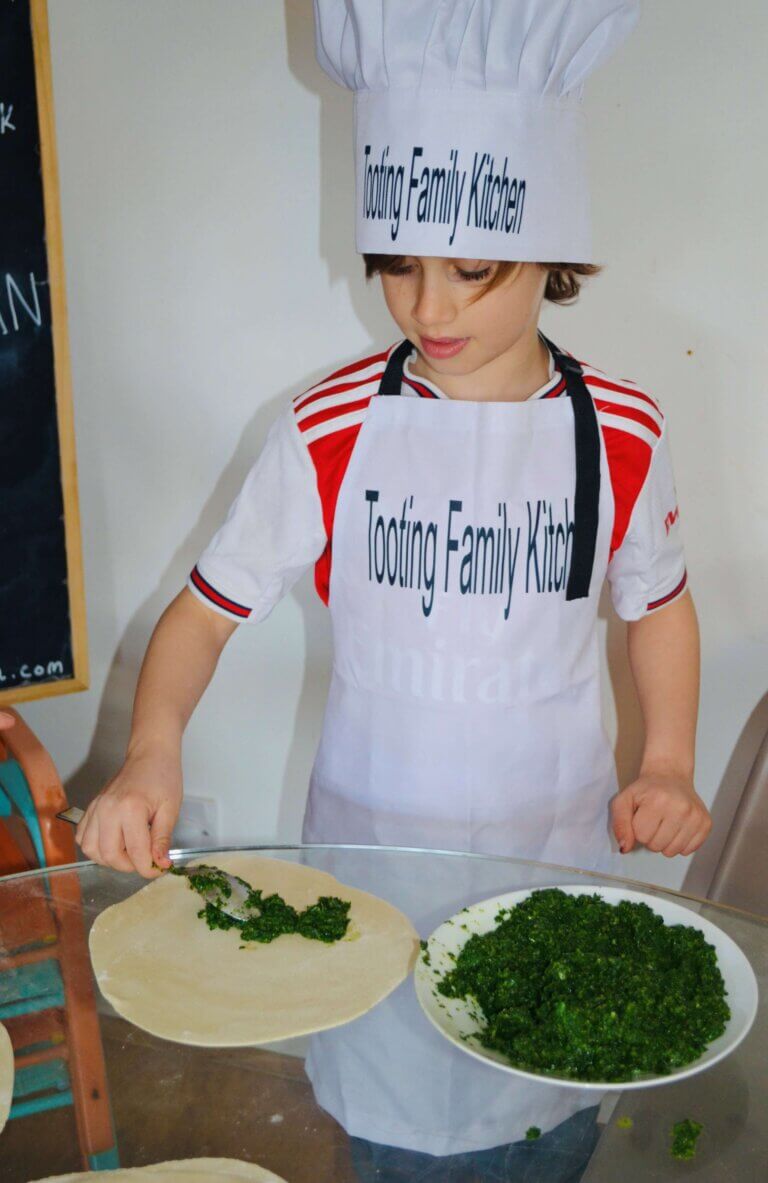
AUSHAK (AFGHAN DUMPLINGS)
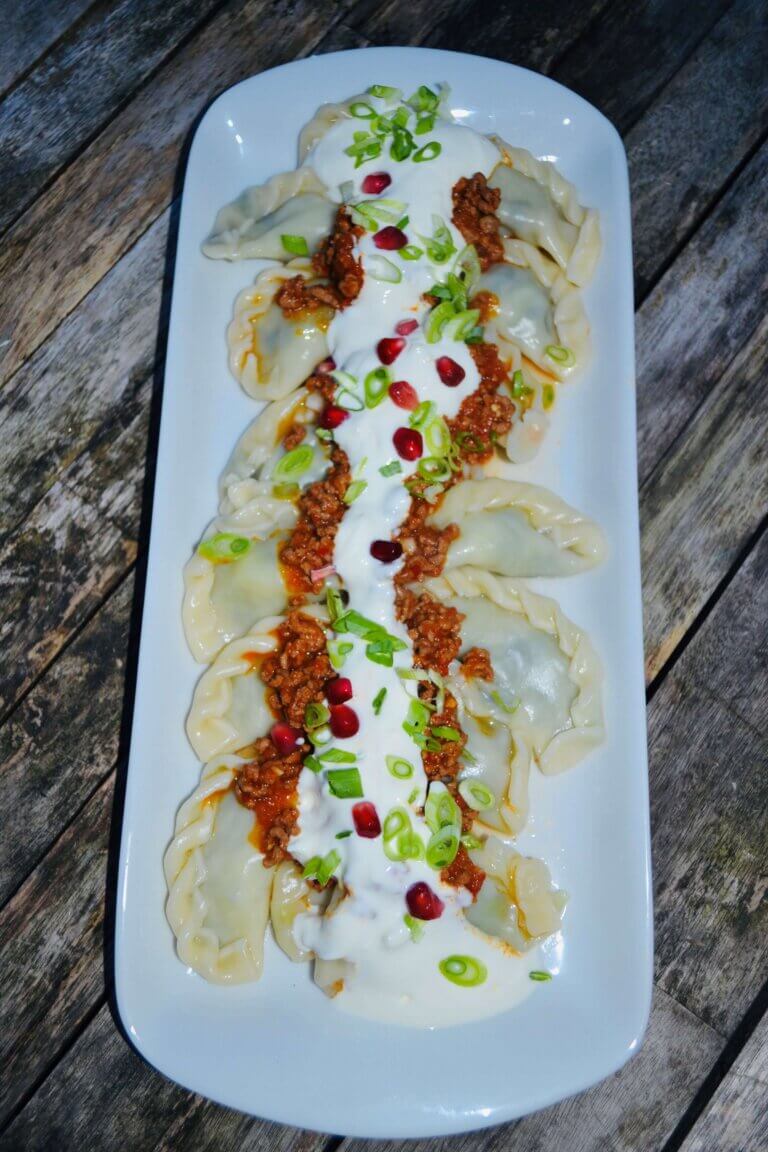
What’s in it...
Dough
500g plain flour, plus extra for kneading
1 tsp salt
1 tbsp vegetable oil
250ml of water
Sauce
2 tbsp oil
500g minced beef
1 large onions, finely chopped
4 cloves garlic, minced
1 red pepper, chopped
1 red chilli, de-seeded and chopped
1 tbsp mild chilli powder
1 tsp ground turmeric
1 tsp salt
400g chopped tomatoes
100 ml water
½ cup split chick peas, cooked
Filling
2 tbsp butter
2 leaks, washed & finely chopped
Handful coriander, chopped
1 tsp freshly ground black pepper
1 tsp salt
Yoghurt sauce (quantity to cover all recipes)
1kg of natural yoghurt (full fat)
6 cloves garlic, minced
50ml of water
1 tsp. of salt
Pomegranate seeds to garnish
What to do with it...
- Mix the flour, salt and oil and gradually add the water until you have achieved a dough like consistency. Turn onto a lightly dusted surface and knead the dough for 10 mins until smooth and spongy and does not stick to fingers. Cover with a damp cloth and rest for 20 mins.
- Heat a heavy bottom and fry the onion for 5 mins until translucent, add the garlic, peppers and chilli and continue to fry for a minute and then add the chilli pod, turmeric and salt followed by the meat and continue cooking until well browned.
- Add the water and tomato and cover and simmer for 1hr. adding the chick peas for the last 5 mins.
- To make the filling, heat up a heavy bottom pan and melt the butter before adding the chopped leaks and coriander, cook for 5 mins until softened and put to one side to cool.
- Roll out the dough and cut into 6 equal pieces and roll into balls. Roll out one at a time until approx. 2mm tick and cut into 5cm discs.
- Pit one heaped tsp of the filling mixture into the centre of each disc and brush the edges with water and the fold over and seal in a semi-circle shape. Repeat until all the dumplings have been filled.
- Make the yoghurt sauce by adding the garlic to the yoghurt and lightly beat with a fork whilst slowly adding the water. No need to use all the water as you just want to make the yoghurt a bit smoother and get some air into it. Garnish with the pomegranate seeds.
- When ready to serve heat up the sauce and bring a big pan of water to the boil. When the water us hot gently pace the dumplings into the water and cook for approx. 3 mins – when cooked they should float to the top.
- Drain well and then spoon over the meat sauce followed by garlic yoghurt and garnish with spring onions.
BORANI BANJAN (AUBERGINE WITH YOGHURT)
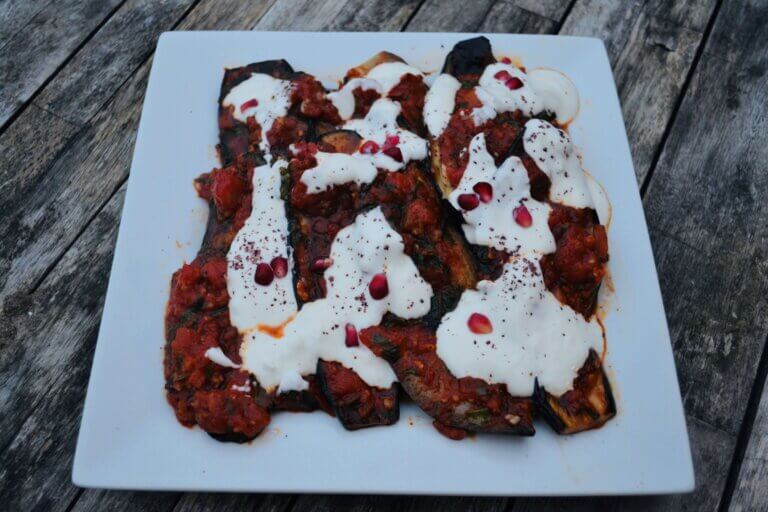
What’s in it...
2 large aubergines
200g chopped tomatoes
6 cloves garlic, minced
¼ cup of olive oil
1 bunch coriander, chopped
1 tsp mild chilli powder
1 tsp turmeric
Salt & Pepper, to season
5 tbsp. garlic yoghurt sauce (from previous recipe)
Pomegranate seeds to garnish
What to do with it...
- Slice the aubergine longways so that they are approx. 1cm thick. Lay all the slice on a metal rack and sprinkle with salt and leave to one side allowing the moisture to be drawn away. When ready to cook, rinse and pat dry with kitchen paper.
- Heat the ½ the oil in large pan and gently fry the garlic for a minute add the tomatoes and cooked for a few minutes until the tomatoes break down slightly and then add the coriander, chilli, turmeric and seasoning and out to one side.
- Heat the remaining oil in a large frying pan/skill set and cook the aubergines on each side until golden brown and softened (most likely in batched). When they are all nice browned off add the tomato sauce to the pan and simmer with the lid on for 5 mins.
- Carefully remove to a plate and allow to cool to room temp before serving with the garlic yoghurt sauce and pomegranates.
BOLANI / PERIKI
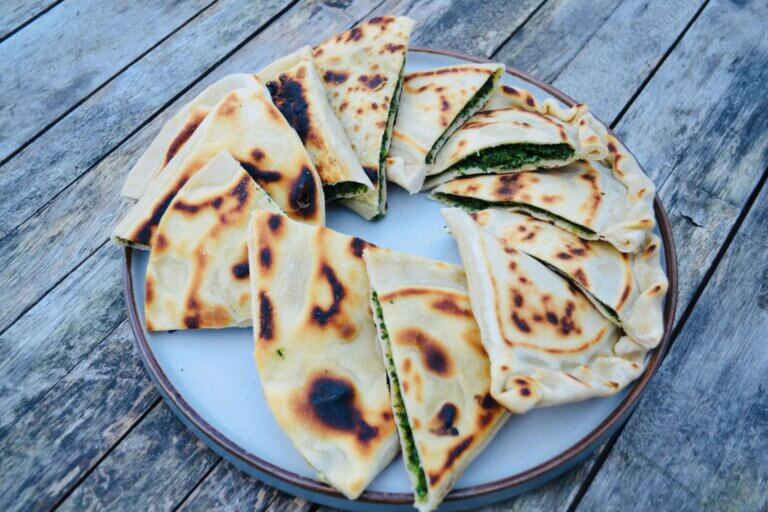
What’s in it...
The dough
500g plain flour, plus extra for kneading
1 tsp salt
1 tbsp vegetable oil
250ml of water
The filling
400g fresh spinach leaves
1 bunch, chopped coriander (leaves and stems)
6 spring onions, chopped
2 tablespoon olive oil
2 tbsp sea salt
Freshly ground black pepper
What to do with it...
- Mix the flour, salt and oil and gradually add the water until you have achieved a dough like consistency. Turn onto a lightly dusted surface and knead the dough for 10 mins until smooth and spongy and does not stick to fingers. Cover with a damp cloth and rest for 20 mins.
- Place the spinach in a large colander and pour over a kettle full of water to wilt – put to one side and allow to cool.
- Add the wilted spinach with the coriander, spring onion, oil and salt to a food processor and blitz until just becoming smooth – don’t over blitz as will become too liquidy. Transfer to a bowl or add to a sieve to get rid of any extra liquid.
- Dive the dough into 6 equal balls and roll each one out on a dusted surface into approx. 15cm discs.
- Add approx. 3 heaped tbsp of the mixture onto half of each disc leaving enough room around the edges to make a seal. Fold the dough over and seal the edges and press down a little to make sure any air is pressed out.
- When ready to cook heat a large frying and brush one side of the bolani’s with oil and fry for approx. 4 mins or until golden brown whilst you brush the other side – then turn and repeat. Depending on the size of the pan you should be able to do 2 at a time. Repeat the process until they are all cooked and keep warm under tin foil.
- Cut into portions and serve alongside garlic yoghurt.
Our Afghan Feast
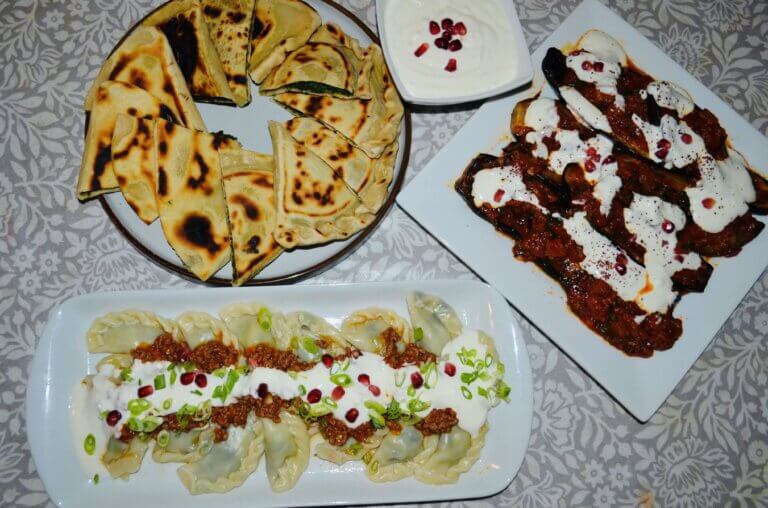
Lets get stuck in!
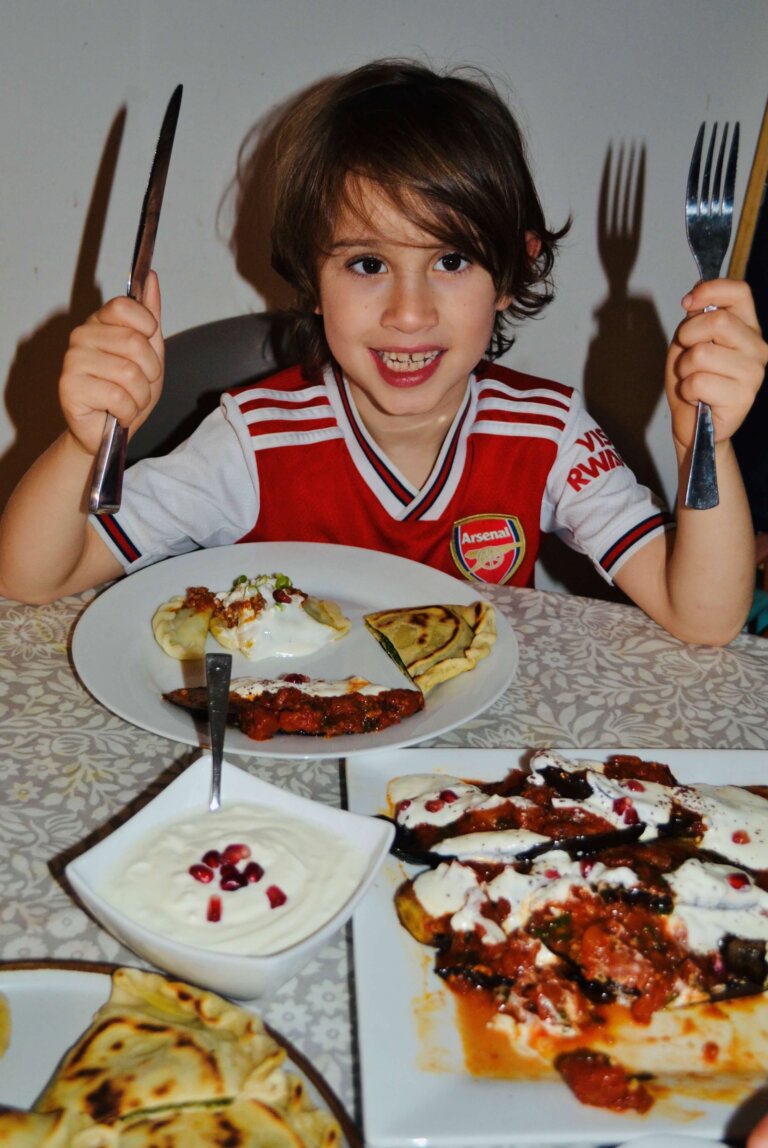
Yummy!
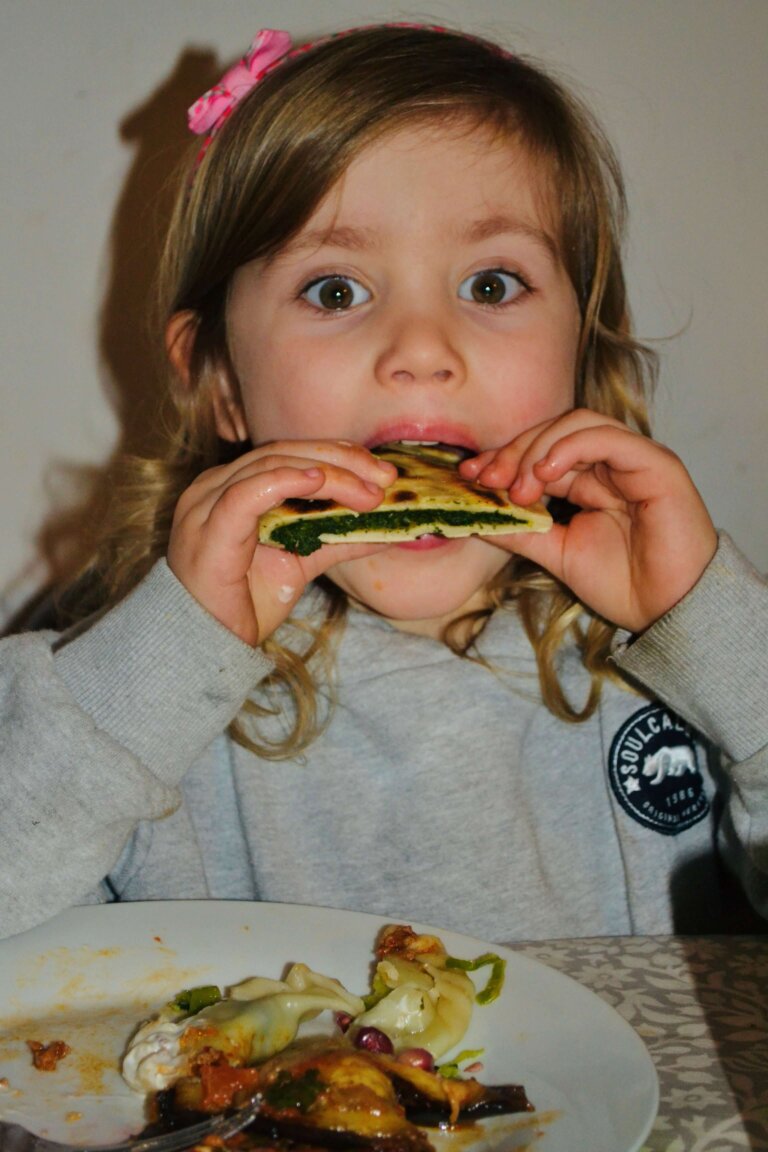
Thank you Afghanistan!
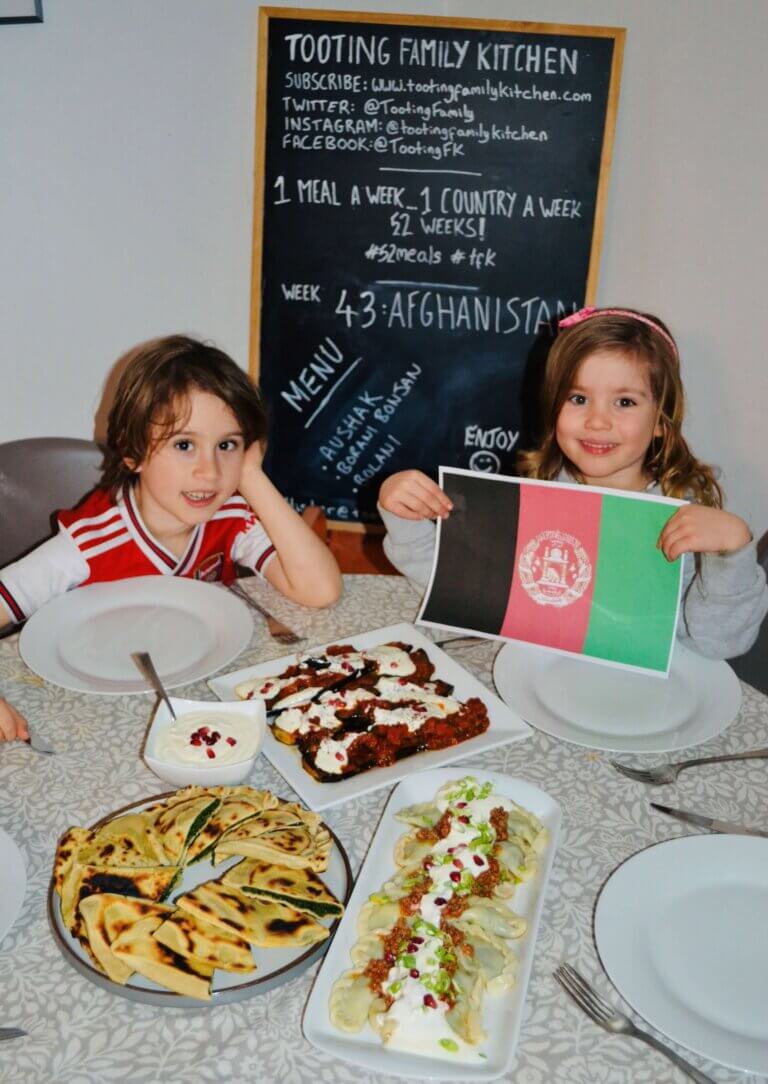
Thank you Afghanistan, that was epic! Can’t wait to explore more of your cuisine.
Next week we are excited to head to Israel!!! … please don’t forget to SUBSCRIBE (scroll to bottom) & SHARE and if you have any International Food ideas or recipes from around the world you wish to share please do drop us a line
Check out other destinations here.
You can also follow us on Instagram, twitter and Facebook
See you next week!
Tooting Family Kitchen
#tootingfamilykitchen #getkidscooking #familycooking #homecooked #worldfood #americanfood #usa #kidscooking #getkidscooking #familycooking #internationalfood #CookingBuddies
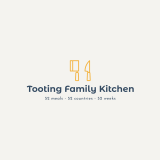

The sport with the carcass and the horsemen sounds definitely sounds like it could get violent :-). Food looks great again!
Great introduction and recipes. Well done, team Richardson!